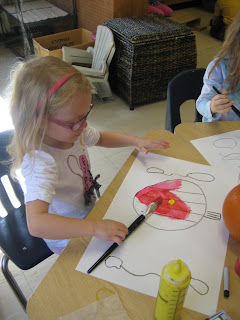The first day we observed the outside of the pumpkins.
At small group we used pastels and sketched the pumpkins.
After using our colour mixing skills, orange and green were created.
The next day, we explored the inside of the pumpkin.
The children made an estimate as to how many seeds were in the pumpkins.
Using groups of 10, we began to count the seeds inside the pumpkin. Looks like much more than 20. They were so surprised that each small pumpkin had over 300 seeds.
Next the children wanted to wash the seeds. We placed them in water and a sensory activity began to occur. They loved the feel of seeds in water.
Some children brought the seeds to the light table to explore. They noticed that the pulp had little strings in it.
The pumpkins were placed at the discovery centre. The children enjoyed observing the pumpkins, trying to match the tops and reading the life cycle of the pumpkin book.
Look at the sketch art on the windows. Beautiful!
When we were observing the seeds in water, the children noticed that some seeds were floating and some were sinking. We decided to separate them into two different jars. After we cut the seeds open, the ones that were floating were hollow inside and the ones that were sinking were full inside. The children were exposed to the words density and buoyant.
The weekend passed and when we entered the classroom our pumpkins were soft and were starting to decompose. We placed a pumpkin in a container and each day we observed the pumpkin and recorded its appearance on a chart.
This pumpkin was left on the porch outside. It was not decomposing. Based on this observation, we concluded that if the pumpkin was in cold temperatures it would decompose slower than if it was left in warmer temperatures.
The pumpkin experiences were planned based on the flow of learning presented by the students. As they pose questions and initiated inquiry, I planned lessons around what they wanted to know. Some of the lessons were designed based on discovery or exploration of the current activity.




















No comments:
Post a Comment